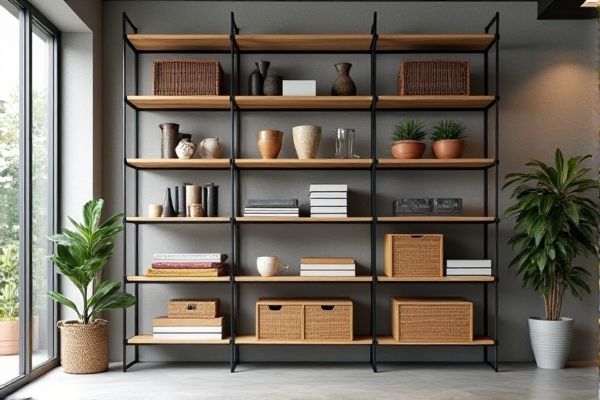
Steel shelving offers superior durability and load-bearing capacity compared to wood shelving, making it ideal for heavy-duty storage and industrial use. Explore the rest of the article to help you decide which material best suits your storage needs and aesthetic preferences.
Table of Comparison
| Feature | Steel Shelving | Wood Shelving |
|---|---|---|
| Durability | High resistance to wear, rust, and impact | Susceptible to scratches, dents, and moisture damage |
| Load Capacity | Supports heavy loads; ideal for industrial use | Better for light to medium loads |
| Maintenance | Low maintenance; easy to clean | Requires regular polishing and protection from moisture |
| Appearance | Modern, industrial look | Warm, classic aesthetic |
| Cost | Generally more affordable long-term | Higher initial cost, especially with quality wood |
| Environmental Impact | Recyclable; depends on manufacturing process | Renewable resource; biodegradable |
| Installation | Typically easy, modular components | May require professional assembly |
Introduction: Steel Shelving vs Wood Shelving
Steel shelving offers superior durability and weight capacity compared to wood shelving, making it ideal for industrial and heavy-duty storage needs. Wood shelving provides a warm aesthetic and is easier to customize for residential or light storage purposes. Your choice depends on whether you prioritize strength and longevity or appearance and versatility.
Material Composition and Durability
Steel shelving offers superior durability due to its high tensile strength and resistance to warping, making it ideal for heavy-duty storage and industrial environments. Wood shelving, composed primarily of hardwood or softwood, provides a more aesthetic appeal but is prone to moisture damage, warping, and insect infestation over time. Steel's corrosion-resistant coatings and load-bearing capacity significantly outlast wood in demanding applications, ensuring long-term reliability.
Load-Bearing Capacity and Strength
Steel shelving offers superior load-bearing capacity and strength compared to wood shelving, supporting heavier weights without bending or warping. Wood shelving may be prone to damage under high loads or over time due to moisture and structural limitations. Your choice hinges on the need for durability and heavy-duty storage, where steel excels in maintaining stability and longevity.
Design Flexibility and Customization
Steel shelving offers superior design flexibility due to its modular components and adjustable configurations, allowing for easy customization to fit various storage needs and space constraints. Wood shelving, while aesthetically pleasing with natural grain patterns, typically requires more effort and expertise to modify or expand, limiting its adaptability. The durability and strength of steel further enhance its customization potential, supporting heavier loads and offering options like powder coating for diverse environments.
Cost Comparison and Budget Considerations
Steel shelving typically costs more upfront than wood shelving but offers greater durability and lower maintenance expenses over time, making it a cost-effective choice for long-term use. Wood shelving generally has a lower initial price and provides aesthetic appeal, but may incur higher costs for repairs, replacements, and susceptibility to damage from moisture or pests. Budget considerations should weigh immediate expenses against lifecycle costs, durability, and the specific environmental conditions of the storage area.
Installation Process and Ease of Assembly
Steel shelving typically features pre-drilled holes and modular components that enable quick, tool-free assembly, making the installation process highly efficient for both commercial and residential use. Wood shelving often requires more time-consuming steps, including measuring, cutting, and fastening with screws or nails, which may demand advanced carpentry skills for proper assembly. The durability and standardized design of steel shelving provide consistent ease of installation compared to the variable complexity found in wood shelving projects.
Maintenance and Longevity
Steel shelving offers superior durability and requires minimal maintenance due to its resistance to moisture, pests, and warping, making it ideal for heavy-duty and long-term use. Wood shelving, while aesthetically pleasing, demands regular upkeep such as polishing, sealing, and protection from humidity to prevent cracking and decay. The longevity of steel shelving generally surpasses wood, especially in environments prone to dampness or heavy load conditions.
Environmental Impact and Sustainability
Steel shelving offers higher recyclability and durability, reducing the need for frequent replacements and minimizing waste, which enhances its environmental sustainability. Wood shelving, while biodegradable and renewable, often involves deforestation and slower regeneration rates unless sourced from certified sustainable forests. Choosing steel shelving made from recycled materials supports circular economy principles, whereas sustainably harvested wood shelving can provide carbon sequestration benefits.
Aesthetic Appeal and Space Integration
Steel shelving offers a sleek, modern aesthetic with clean lines and a minimalist design that easily complements contemporary interiors, while wood shelving provides a warm, natural look that adds character and rustic charm to any space. Your choice between steel and wood shelving should consider the room's overall style and the desired balance between industrial edge and cozy ambiance. Steel units typically integrate better into modern, urban settings due to their slim profiles and metallic finishes, whereas wood shelves blend seamlessly into traditional or eclectic spaces, enhancing warmth and texture.
Best Applications: Choosing the Right Shelving for Your Needs
Steel shelving is ideal for heavy-duty storage in industrial settings, warehouses, or garages due to its durability, load-bearing capacity, and resistance to moisture and pests. Wood shelving offers a warmer aesthetic and is best suited for residential use, light to moderate loads, and decorative storage where appearance matters. Your choice depends on the environment, weight requirements, and whether durability or design is your priority.
 homyna.com
homyna.com